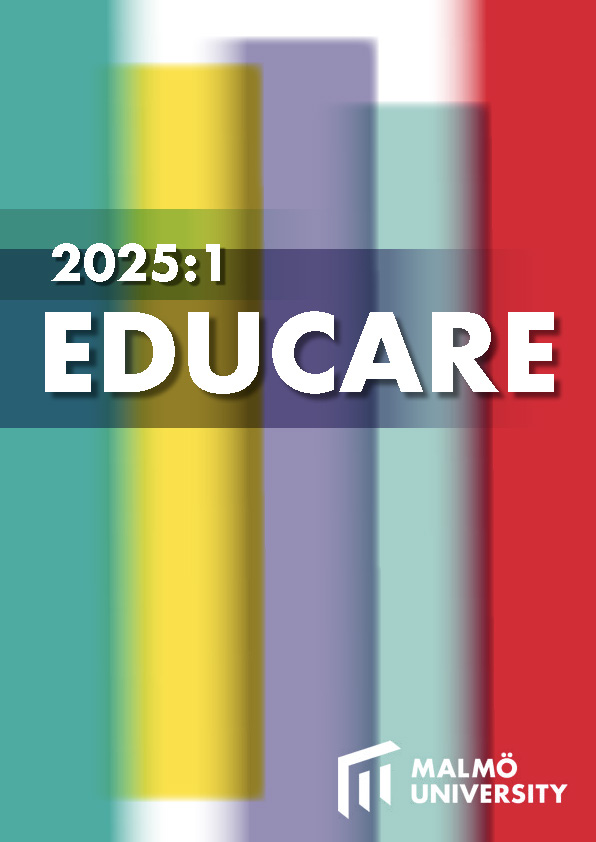“Fem tysta” och andra disciplinerande strategier
Barns perspektiv på fritidshemmets rutinsituationer
DOI:
https://doi.org/10.63310/edu.2025.1.48256Keywords:
omsorg, barns perspektiv, fritidshem, rutinerAbstract
In this study, we take the concept of care in school-age educare centres’ routine situations as a point of departure in order to make visible children’s perspective on the task of care and relations. The study is based on group interviews with 170 children in 45 groups (ages 6-11) from twelve different centers. In the study the concepts of care, relationships and time hold a central analytical position in the analysis of the children’s expression. The results of the analysis are shown in three themes: Wandering between different time slots morning and afternoon, Snack-time structured through hourglasses and "five silent" and It's not so fun to stay until closing time. Overall, the study’s analysis reveals a picture of the school-age educare centres’ routine situations as deeply problematic and morally challenging, where the children are socialized into routines free from care and meaning.
References
Ackesjö, H., & Haglund, B. (2021). Fritidspedagogisk undervisning: En fråga om intentionalitet, situationsstyrning och inbäddning. Utbildning och Lärande, 15(1), 69–87. DOI: https://doi.org/10.58714/ul.v15i1.11230
Alasuutari, M., Markström, A-M., & Vallberg Roth, A-C. (2014). Assessment and documentation in early childhood education. Routledge. DOI: https://doi.org/10.4324/9781315818504
Alvesson, M., & Sköldberg, K. (1994). Tolkning och reflektion: Vetenskapsfilosofi och kvalitativ metod. Studentlitteratur.
Andersson, B. (2020). Fritidshemmets utveckling ur ett styrningsperspektiv. I B. Haglund, J. Gustafsson Nyckel & K. Lager (Red.), Fritidshemmets pedagogik i en ny tid. (s. 35-58). Gleerups.
Blumer, H. (1969.) Symbolic interactionism, perspective, and method. University of California press, Ltd.
Borg, A-L. (2023). ‘This place does not feel safe’: safe and unsafe spaces in Swedish school-age educare. Children’s geographies, 21(6), 1044-1057. DOI: 10.1080/00222216.2023.2268622 DOI: https://doi.org/10.1080/14733285.2023.2175315
Boström, L., Elvstrand, H., & Orwehag, M. (2022). In search of didactics in school-age educare centres: To conceptualize what exists but has not yet been found. Nordisk tidsskift for pedagogikk og kritikk, 8(1). DOI: 10.23865/ntpk.v8.3335 DOI: https://doi.org/10.23865/ntpk.v8.3335
Boström, L., Elvstrand, H., & Orwehag, M. (2022). Didactics in school-age educare centres – An unexplored field but with distinctive views. Social Sciences & Humanities Open, 6(1). DOI: 10.1016/j.ssaho.2022.100333 DOI: https://doi.org/10.1016/j.ssaho.2022.100333
Dahl, H. M., & Hansen, L. L. (2021). Introduction: A care crisis in the Nordic welfare states? I L. L. Hansen, H. M. Dahl & L. Horn (red.), A care crisis in the Nordic welfare states? (pp. 1-19). Cambridge University Press. DOI: https://doi.org/10.46692/9781447361374.002
Davies, K. (1996). Önskningar och realiteter: om flexibilitet, tyst kunskap och omsorgsrationalitet i barnomsorgen. Carlsson.
Haglund, B. (2004). Traditioner i möte: en kvalitativ studie av fritidspedagogers arbete med samlingar i skolan. [Doktorsavhandling, Göteborgs universitet].
Haglund, B. (2015). Pupil’s opportunities to influence activities: a study of everyday practice at a Swedish leisure-time centre. Early Child Development and Care, 185(10), 1556–1568. DOI: 10.1080/03004430.2015.1009908 DOI: https://doi.org/10.1080/03004430.2015.1009908
Haglund, L. (2019). The need for care: A study of teachers’ conceptions of care and pupils’ needs in a Swedish school-age educare setting. International Journal for Research on Extended Education, 7(2), 191-206. DOI: https://doi.org/10.3224/ijree.v7i2.07
Hansen, L.L., Bjørnholt, M., & Horn, L. (2021). Fraser’s care crisis theory meets the Nordic welfare societies. I L. L. Hansen, H. M. Dahl & L. Horn (red.) A care crisis in the Nordic welfare states? (pp. 39-59). Cambridge University Press. DOI: https://doi.org/10.46692/9781447361374.004
Hedrén, S. (2022). Fritidshemmets (mellan)mål och mening: Positioneringar i kollegialt samtalande mellan fritidshemspersonal. [Doktorsavhandling, Högskolan Väst].
Hennik, M. M. (2014). Focus group discussions. Oxford University Press.
Hjalmarsson, M. (2018). The presence of pedagogy and care in leisure-time centres’ local documents: Leisure-time teachers’ documented reflections. Australasian Journal of Early Childhood, 43(4), 57-63. DOI: 10.23965/AJEC.43.4.07 DOI: https://doi.org/10.23965/AJEC.43.4.07
Hjalmarsson, M., & Löfdahl, A. (2014). Omsorg i svenska fritidshem: fritidspedagogers etiska förmåga och konsekvenser för barn. BARN, 32(3), 91–105. DOI: https://doi.org/10.5324/barn.v33i3.3503
Holmberg, L. (2017). Lärande genom demokratiska önskemål – pastoral omsorg i fritidshem. Pedagogisk Forskning i Sverige, 22(1-2), 28-50.
James, N. (1992). Care = organisation + physical labour + emotional labour. Sociology of Health & Illness, 14(4), 488–509. DOI: https://doi.org/10.1111/1467-9566.ep10493127
Klerfelt, A., & Haglund, B. (2014). Presentation of research on school-age educare in Sweden. International Journal for Research on Extended Education, 2(1) 45–62. DOI: https://doi.org/10.3224/ijree.v2i1.19533
Lager, K. (2020). Possibilities and impossibilities for everyday life: Institutional spaces in school-age educare. International Journal for Research on Extended Education, 8(1), 22-35. DOI: 10.3224/ijree.v8i1.03 DOI: https://doi.org/10.3224/ijree.v8i1.03
Lager, K., & Gustafsson-Nyckel, J. (2022). Meaningful leisure time in school-age educare: The value of friends and collective strategies. Education in the North, 29(1), 84-100. DOI: 10.26203/spn0-8f76
Lago, L., & Elvstrand, H. (2019). ”Jag har oftast ingen att leka med”: Sociala exkludering på fritidshem. Nordic Studies in Education, 39(2), 104-120. DOI: https://doi.org/10.18261/issn.1891-5949-2019-02-03
Merriam, S.B. (1994). Fallstudien som forskningsmetod. Studentlitteratur
Moss, P. (2018). What place for ‘Care’ in early childhood policy? I L. Miller, C. Cameron, C. Dalli & N. Barbour (Red.), The SAGE handbook of early childhood policy. SAGE. DOI: https://doi.org/10.4135/9781526402004.n16
Noddings, N. (2002). Starting at home: caring and social policy. University of California Press. DOI: https://doi.org/10.1525/9780520927568
Noddings, N. (2012) The caring relation in teaching. Oxford Review of Education, 38(6), 771-781. DOI: https://doi.org/10.1080/03054985.2012.745047
Orwehag, M. (2020). Didaktik i fritidshemmet. I B. Haglund, J. Gustafsson Nyckel, & K. Lager (Red.), Fritidshemmets pedagogik i en ny tid (s.139–170). Gleerups.
Skolinspektionen. (2010). Kvalitet i fritidshem. Skolinspektionens rapport 2010:3.
Skolinspektionen. (2018). Undervisning i fritidshemmet inom områdena språk och kommunikation samt natur och samhälle. Skolinspektionens rapport.
SOU 1997:21. Växa i lärande. Förslag till läroplan för barn och unga 6–16 år. Delbetänkande av Barnomsorg och skolakommittén. Utbildningsdepartementet.
SOU 2020:34. Stärkt kvalitet och likvärdighet i fritidshem och pedagogisk omsorg. Betänkande av Utredningen om fritidshem och pedagogisk omsorg. https://www.regeringen.se/rattsliga-dokument/statens-offentliga-utredningar/2020/06/sou-202034/
Tronto, J. (1989). Ethics and aging: Bringing the issues home. Generations: Journal of the American Society on Aging, 22(3), 15-20.
Ve, H. (1982). Makt, intresse och socialisation. Kvinnovetenskaplig tidskrift, 3(2), 23–32, 67. DOI: https://doi.org/10.55870/tgv.v3i2.5839
Vetenskapsrådet. (2017). God forskningssed. (Reviderad utgåva). Vetenskapsrådet.
Warin, J. (2014). The status of care: Linking gender and ‘educare’. Journal of Gender Studies, 23(1), 93–106. DOI: https://doi.org/10.1080/09589236.2012.754346
Wearness, K. (1984). The rationality of caring. Economic and Industrial Democracy, 5(2), 185-211. DOI: https://doi.org/10.1177/0143831X8452003
Willis, P. (1997). TIES: Theoretically informed ethnographic study. I S. Nugent & C. Shore (Red.), Anthropology and Cultural Studies (pp. 182-192). Pluto Press.
Published
How to Cite
Issue
Section
License

This work is licensed under a Creative Commons Attribution-NonCommercial 4.0 International License.



